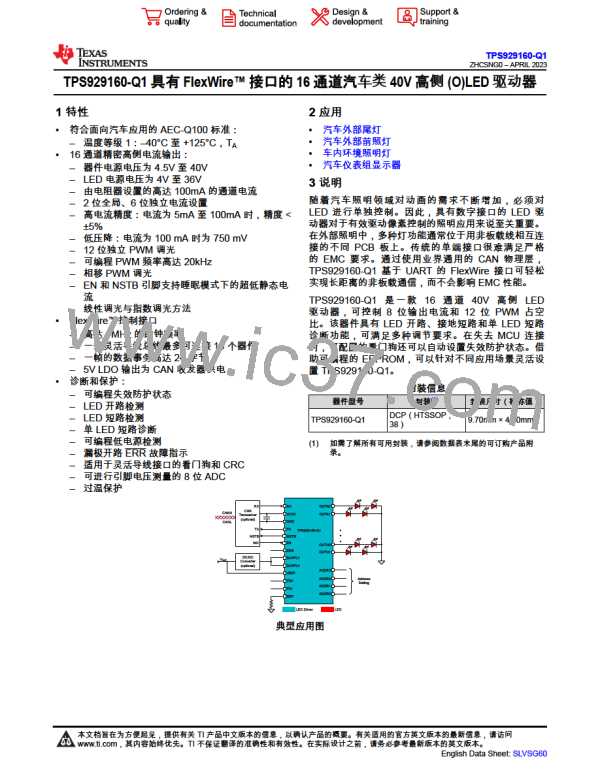TPS929160-Q1
ZHCSNG0 – APRIL 2023
www.ti.com.cn
The low-supply warning is also used to disable the LED open-circuit detection and single-LED short-circuit
detection. When the voltage applied on SUPPLY pin is higher than the threshold V(LOWSUPTH), the TPS929160-
Q1 enables LED open-circuit and single-LED short-circuit diagnosis. When V(SUPPLY) is lower than the threshold
V(LOWSUPTH), the device disables LED-open-circuit detection and single-LED short-circuit diagnosis. Because
when V(SUPPLY) drops below the maximum total LED forward voltage plus required V(OUT_drop) at required
current, the TPS929160-Q1 is not able to deliver sufficient current output. The device pulls the voltage of each
output channel as close as possible to the V(SUPPLY). In this condition, the LED open-circuit fault or single-LED
short-circuit fault can be detected and reported by mistake. Setting the low-supply warning threshold high
enough can avoid the LED open-circuit and single LED short-circuit fault being detected when V(SUPPLY) drops to
low. The V(LOWSUPTH) is programmable from 4 V to 35 V at 1-V interval.
7.3.7.3 Supply Undervoltage Diagnostics in NORMAL State
The TPS929160-Q1 provides internal analog comparator to monitor the supply voltage for undervoltage
protection.
If the supply voltage falls below the internal threshold, V(SUPUV_th_falling), the device pulls the ERR pin low with
constant current sink to report the fault and set flag registers including FLAG_SUPUV and FLAG_ERR to 1.
The supply undervoltage detection is used to disable all current output. When the voltage applied on the
SUPPLY pin is higher than the threshold V(SUPUV_th_rising), the TPS929160-Q1 enables all current outputs. When
V(SUPPLY) is lower than the threshold V(SUPUV_th_falling), the device disables every output to avoid the unwanted
LED flickering or output fault triggered improperly.
The fault is latched in flag registers. When the supply voltage rises above V(SUPUV_th_rising), the master controller
must write register CLRFAULT to 1 to clear FLAG_SUPUV and FLAG_ERR. The CLRFAULT bit automatically
returns to 0.
7.3.7.4 Reference Diagnostics in NORMAL state
The TPS929160-Q1 integrates diagnostics for REF resistor open and short fault. The device monitors the
reference current I(REF) set by external resistor R(REF). The I(REF) can be calculated with the following equation.
V
(REF)
I(REF)
=
R(REF)
(7)
where
V(REF) = 1.235 V typically
•
If the current output from REF pin I(REF) is lower than I(REF_OPEN_th), the reference resistor open-circuit fault
is reported. The reference resistor short-circuit fault is reported if the voltage of REF pin V(REF) is lower than
V(REF_SHORT_th). The device pulls the ERR pin down with constant current sink and set flag registers including
FLAG_REF and FLAG_ERR to 1.
The fault is latched in flag registers. After the REF pin I(REF) and V(REF) recover to normal, the device releases
ERR pin pulldown automatically and the master controller must send CLRFAULT to clear FLAG_REF and
FLAG_ERR. The CLRFAULT automatically returns to 0.
In NORMAL state, the device does not perform any actions automatically when the reference resistor fault is
detected. However, the output can not work properly and the output current can be operating at high current
level. TI recommends for master controller to shut down the device outputs and report error to upper level control
system such as Body Control Module (BCM).
7.3.7.5 Pre-Thermal Warning in NORMAL state
The TPS929160-Q1 has pre-thermal warning at typical 135°C.
Copyright © 2023 Texas Instruments Incorporated
Submit Document Feedback
29
Product Folder Links: TPS929160-Q1
English Data Sheet: SLVSG60

 TI [ TEXAS INSTRUMENTS ]
TI [ TEXAS INSTRUMENTS ]